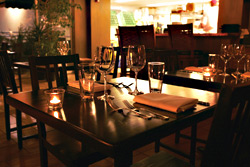When a hermit crab’s squishy lower half begins pressing too firmly against the walls of an adopted shell, the crab goes hunting for a vacant one. Then it scuttles from the old home to the new, shimmying its curled belly up into the spiral. Some crabs covet the shells of still-living mollusks and have to eat the old inhabitant before settling in. Others have to battle neighboring crabs for the most desirable locations or, even worse, curl themselves into bottle caps or airplane-sized liquor bottles.
Growing out of your home can be tricky.
Asteroid Cafe’s move to a larger shell was smooth, but the fit might not yet be perfect. The original Wallingford space, which opened in 1996, “redefined intimate,” laughs manager Victoria Brooks. Most people I’ve talked to remember folding themselves into their seats, where they’d inevitably be smashed up against one of their neighbors or the ex of an ex. The size put off some. For others, it was the place’s secondary charm. The primary charm, most agree, was the Italian food—bold, polished, and reliable.
When Red Apple shut down its Fremont store last year, Marlin Hathaway, Asteroid Cafe’s owner, got a lead on the market’s old wine bar, which Brooks estimates is six or seven times bigger than the restaurant’s original location. Hathaway redecorated the space, painting the walls a deep bronze and installing cherry-wood tables and a hand-worked copper bar. Asteroid—minus the “Cafe” and the large rock that overshadowed the entrance—opened in May.
On my visits to Asteroid: The Restaurant, I brought guests who have been customers of the cafe since the 1990s. All say that the new place feels completely different. The rich hues certainly warm up the room but can’t erase a prefab, supermarket-esque bone structure. Whether you like it or not, there’s now enough space to separate conversations and cooking aromas.
Some things, however, haven’t changed. Hathaway still posts political screeds for you to read while you wait for the bathroom. All his pastas still come from Seattle outfit Cucina Fresca.
And the waiters still treat you like you’re squeezed together in a shoe box. “Is it OK if I special both your tables at the same time?” asked our waiter, addressing my party as well as the one next to us. In his best fifth-grade-speech-contest voice, he described four or five dishes not on the already large menu, eyes rolling up a little as he read off the notes in his head. “That’s nothing,” he said when we congratulated him. “My record is four tables at once.”
If the rest of our waiter’s service was a performance, it wasn’t a ham job. He stayed away when the table talk was rolling and quietly saw to it that the courses arrived at a steady pace. Same thing on my second visit, where our server seemed so genuinely hey-how-ya-doin’ that if the circumstances were different, I would have scooted over and invited her to have a drink with us.
Meals still start with a tiny, savory bruschetta to whet the appetite. And the first special the waiters recite is still a pair of larger ones ($7.95)—say, black-olive tapenade and braised fennel, onions, and potatoes. Get them. An appetizer of squid sautéed with Mama Lil’s pickled peppers ($11.95) came off oddly gummy, but a spinach salad with roasted walnuts and dabs of goat cheese ($7.50) had just the right touch of balsamic vinaigrette, and the full force of the anchovies and garlic came through in the Caesar salad ($6.95).
Roasted pheasant ($23.95) was brined long enough to preserve its juices, and the fennel-haunted spice mix rubbed over the top was lovely, as was the accompanying saffron-asparagus risotto. Pink-centered lamb chops ($23.95) were nestled in a pool of creamy polenta, with a red-wine reduction sauce around the edges. This being Seattle, everyone at the table—not just the food critic—complimented the food but noticed something off. “My dish is really good, except it’s a fall dish,” my friend Jennifer said, waving her fork over a fluffy fagioli in torta (white-bean cake, $21.95), served over root vegetables braised in an earthy port-porcini sauce. We looked around: Pheasant, beans, lamb, salads— all were divorced from the seasonality that I associate so strongly with Italian food.
The waiters were quick to trumpet Asteroid’s 160-bottle wine list, whose prices go from the low two digits to three. But almost every bottle we tried ordering was out of stock, or the waiters had to substitute a newer vintage. Now, I’m no wine geek—all I care is that it tastes great, and from the southern Italian Salice Salentino to the Napa cab, the selections we ended up with did—but that’s a grave error for serious wine drinkers.
Whatever their season, the inexpensive pastas were a reminder of how much presence properly al dente pasta has, and how assertive the flavor of wheat. From the simplest penne al pomodoro ($13.95) with a kicky tomato sauce and goat cheese to the full-on romp of a penne puttanesca ($13.95) sauced with tomatoes, capers, garlic, black olives, and anchovies, they were all—still—bold, polished, and reliable.
It feels like Asteroid hasn’t resolved dueling ambitions: the old, to be a quirky, familial neighborhood restaurant; and the new, to be a white-tablecloth kind of place. Perhaps it just needs a little more time to shimmy into the new shell.






